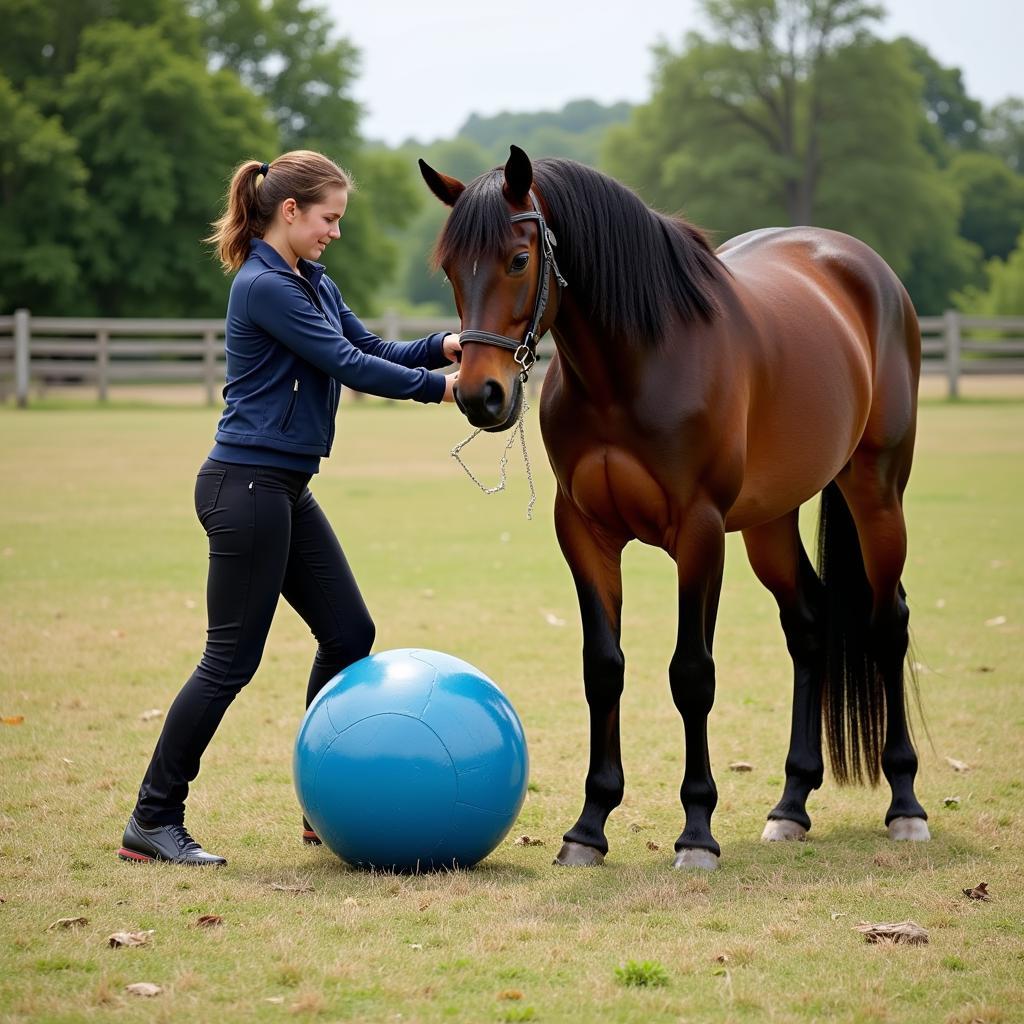Desensitizing a horse is a crucial aspect of training that helps them remain calm and safe in various situations. It involves exposing your horse to different stimuli and experiences in a controlled and positive manner, gradually building their confidence and reducing fear or reactivity.
Understanding Desensitization
Before diving into techniques, it’s important to understand the concept of desensitization. Horses are prey animals, naturally programmed to react quickly to potential threats. This instinct, while vital in the wild, can lead to spooking, bolting, or other dangerous behaviors in domesticated environments.
Desensitization works by teaching your horse that these perceived “threats” are not actually dangerous. This is achieved through gradual exposure, positive reinforcement, and building trust between you and your horse.
Essential Tools for Desensitizing Your Horse
 Horse Desensitization Tools
Horse Desensitization Tools
Having the right tools can make the desensitization process smoother and more effective. Here are some essentials:
- Rope Halter: Provides gentle pressure points for clearer communication.
- Lead Rope: Allows you to control your horse’s movement and maintain a safe distance.
- Training Flag: Introduces movement and sound in a controlled way.
- Treats: Rewards desired behaviors and builds positive associations.
- Patience: Most important tool! Desensitization takes time and consistency.
Techniques for Effective Desensitization
Desensitizing a horse is a gradual process that requires patience, consistency, and a calm demeanor. Here are some effective techniques:
1. Start Small and Gradual
Begin with less intimidating objects or situations. Introduce the stimulus from a distance, gradually decreasing the distance as your horse remains relaxed.
2. Use Positive Reinforcement
Reward your horse generously for calm and accepting behavior. This could be with treats, verbal praise, or a gentle scratch.
3. Introduce Variety
Don’t limit desensitization to just a few objects. Introduce a wide range of stimuli: different textures, sounds, and experiences.
4. Watch Your Horse’s Body Language
Pay close attention to your horse’s reactions. Signs of stress include pinned ears, a raised head, or a swishing tail. If your horse shows anxiety, back away from the stimulus and approach it again later at a greater distance.
5. Consistency is Key
Desensitization is not a one-time fix. Regular and consistent sessions will yield the best results.
Common Desensitization Exercises
 Horse Desensitization Exercises
Horse Desensitization Exercises
There are numerous exercises you can use to desensitize your horse. Here are a few examples:
- Flag Work: Introduce the training flag slowly, waving it gently at a distance and gradually moving closer.
- Object Introduction: Introduce objects like tarps, buckets, or even umbrellas. Allow your horse to sniff and investigate at their own pace.
- Sound Desensitization: Play various sounds from a distance, such as traffic noises, machinery, or music. Gradually increase the volume as your horse becomes accustomed.
- Trail Obstacles: Introduce trail obstacles like bridges, water crossings, or logs in a safe and controlled environment.
Desensitization Challenges and Solutions
Even with the best efforts, you may encounter challenges during the desensitization process.
Problem: Horse remains fearful or reactive despite gradual introduction.
Solution: Break down the process into even smaller steps. Seek guidance from an experienced trainer if needed.
Problem: Horse becomes overly reliant on treats.
Solution: Gradually reduce the frequency of treats, replacing them with verbal praise and petting.
Problem: Horse’s fear response escalates quickly.
Solution: Immediately remove the stimulus and return to a previously comfortable stage. Ensure you are not accidentally reinforcing fearful behavior.
The Importance of Patience and Consistency
Desensitizing your horse is an ongoing process that requires patience, understanding, and a commitment to building a trusting partnership. By investing time and effort in desensitization, you can help your horse become calmer, more confident, and safer in a variety of situations.
Remember, every horse learns at their own pace. Some may take to desensitization quickly, while others may require more time and patience. Celebrate the small victories and always prioritize your horse’s well-being.
Frequently Asked Questions
Q: Can any horse be desensitized?
A: Yes, with the right approach and patience, most horses can be desensitized to a wide range of stimuli.
Q: How long does it take to Desensitize A Horse?
A: There’s no set timeframe. It depends on the individual horse, the type of stimuli, and the consistency of training.
Q: What if my horse’s fear response is extreme?
A: It’s crucial to seek professional help from an experienced trainer or equine behaviorist. They can assess the situation and create a tailored desensitization plan.
Do you have other questions about horses that are scared? Check out our article about horses scared for more information.
Desensitizing your horse is an investment in their well-being and your safety. It strengthens your bond and opens up a world of enjoyable experiences together. Remember, a calm and confident horse is a happy horse.
For more helpful tips on calm your horses, browse our other articles on the Justus Horses USA website.
If you need help desensitizing your horse or have any questions, please don’t hesitate to contact us. Call us at 0772127271, email us at [email protected], or visit our location at QGM2+WX2, Vị Trung, Vị Thuỷ, Hậu Giang, Việt Nam. We have a 24/7 customer support team ready to assist you.